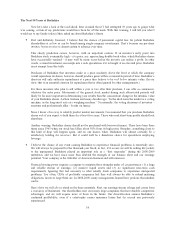Berkshire Hathaway 2014 Annual Report Download - page 30
Download and view the complete annual report
Please find page 30 of the 2014 Berkshire Hathaway annual report below. You can navigate through the pages in the report by either clicking on the pages listed below, or by using the keyword search tool below to find specific information within the annual report.I’ve yet to see an investment banker quantify this all-important math when he is presenting a stock-for-
stock deal to the board of a potential acquirer. Instead, the banker’s focus will be on describing “customary”
premiums-to-market-price that are currently being paid for acquisitions – an absolutely asinine way to evaluate the
attractiveness of an acquisition – or whether the deal will increase the acquirer’s earnings-per-share (which in itself
should be far from determinative). In striving to achieve the desired per-share number, a panting CEO and his
“helpers” will often conjure up fanciful “synergies.” (As a director of 19 companies over the years, I’ve never heard
“dis-synergies” mentioned, though I’ve witnessed plenty of these once deals have closed.) Post mortems of
acquisitions, in which reality is honestly compared to the original projections, are rare in American boardrooms.
They should instead be standard practice.
I can promise you that long after I’m gone, Berkshire’s CEO and Board will carefully make intrinsic value
calculations before issuing shares in any acquisitions. You can’t get rich trading a hundred-dollar bill for eight tens
(even if your advisor has handed you an expensive “fairness” opinion endorsing that swap).
************
Overall, Berkshire’s acquisitions have worked out well – and very well in the case of a few large ones. So,
too, have our investments in marketable securities. The latter are always valued on our balance sheet at their market
prices so any gains – including those unrealized – are immediately reflected in our net worth. But the businesses we
buy outright are never revalued upward on our balance sheet, even when we could sell them for many billions of
dollars more than their carrying value. The unrecorded gains in the value of Berkshire’s subsidiaries have become
huge, with these growing at a particularly fast pace in the last decade.
Listening to Charlie has paid off.
28
























